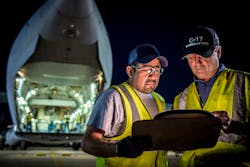Newly minted Boeing Global Services (BGS) is casting a wide net in quest of US$50-billion in annual revenues. The issues for the aerospace industry are the reach of that net, and just how finely woven it is.
Stan Deal, BGS’s president and CEO, has some answers. First off he contends this is much more than a counter-cyclical play by Boeing, more than a way by which the parent company cushions the impact of future slow times in its commercial and defense aircraft manufacture.
“There’s an element of that,” accedes Deal. But he asserts the underlying rationale for launch of BGS is that the services arena overall has been largely underserved by Boeing.
Consider, “We produce a little over half of the commercial aircraft around the world, yet we’re only about 7 percent commercially in [the] services market segment,” says Deal. “On the defense side, we roughly produce about half the Free World’s defense products,” yet Boeing provides a scant 9 percent of the services attendant to that key sector.
Looking ahead to the second century of its existence, Boeing sought to see where it could position itself for growth. Services seemed “like a big opportunity,” says Deal. Indeed, $50 billion in yearly revenues from assorted services is a very big deal indeed.
“We’ve done our homework,” he says. “Certainly it’s a doable aspiration … I’m driving the team inside Boeing to [work] more towards the five- than the 10-year” timeframe to hit the US$50 billion target. Boeing estimates the aggregate commercial and services market over the next 10 years at $US2.6 trillion
Evidence of BGS’s new stature is that it’s now categorized within the company as Boeing’s “third major business unit” according to a prepared release, “operating alongside Commercial Airplanes as well as Defense, Space & Security.”
Headquartered in suburban Dallas, this new business unit will focus on four broad areas:
- Supply chain;
- Engineering, modifications & maintenance;
- Digital aviation & analytics;
- Training & professional services.
Growth will come organically and acquisitionally. Innovation will be the key, says Deal. “First, we’re going to look at organic growth as our No. 1 priority. Our focus has been ramping up innovation … around services.”
Even before BGS was officially launched as a co-equal business unit it got a bit of a head start on revving up innovation initiatives. “Last year we produced 17 new innovative services to take to market,” says Deal, “all centered on trying to bring value to an airline or government.”
He says the aim is to scale up incubation of new services so as to produce some 100 of them per year. Despite the disparate nature of those services, Deal says they all have a couple of things in common: “increasing utilization of the airplane, or lowering the cost to operate the airplane. That’s where we think the added value is … But I will continue to look at niche plays that continue to expand organically. Those aren’t off the table.”
Case-in-point: the 2015 purchase of Peters Software GmbH, a provider of European Aviation Safety Agency (EASA) based content for ab-initio pilot training. Boeing’s own Pilot and Technician Outlook says airlines are going to require some 558,000 new pilots over the next 20 years.
Peters Software is part of Boeing’s “track record of making acquisitions,” says Deal, especially where the cockpit is concerned. In 2000 it bought Jeppesen, which recently introduced FlightDeck Pro 3,0/9.0. “The third generation of software” brought navigation, manuals, weather updates trip planning and maintenance management records into “a more integrated format.” Deal believes the resultant Electronic Flight Bag (EFB) “takes that integration to a supercharged level.”
Understanding where BGS is going to derive that hoped-for US$50 billion per year means understanding the term ‘services’ takes in a lot of territory.
BGS is into crew scheduling too, specifically via a crew disruption management application. Deal says it tackles the challenge of “how you get the crew schedule re-optimized to re-start fast, safe and compliant with FAA rules and work rules negotiated with the labor force within an airline.”
It’s the sort of app whose reason-for-being is ripped right from the headlines of recent air carrier history.
MRO Initiatives
More in keeping with traditional definition of ‘services’ is Boeing announcement that it’s partnering with China’s Taikoo (Shandong) Aircraft Engineering Co. Ltd in an ambitious Boeing 737-800 passenger-to-freighter conversion program. STAECO joins Boeing Shanghai Aviation Services in the effort.
“It’s a large set of capabilities that we have out there,” says Deal. “Our innovations continue to repurpose our airplanes and other people’s airplanes…to extend their life.”
BGS is moving “off platform,” not confining itself solely to Boeing products. “We’ve modified C-130s. We’ve modified A-10s and re-winged them.”
In yet another niche, Boeing and Taiwan-based China Airlines has inked a memorandum of understanding to, according to a prepared release, “explore the development of the airline’s capabilities to serve the growing maintenance, repair and overhaul market in Asia.” Boeing says it intends to work closely with the carrier to qualify it as an approved Boeing supplier. That will allow China Airlines to bid for work on Boeing products.
In the increasingly important logistics arena BGS is the United States Air Force’s performance-based logistics provider. In taking care of the company product Deal says BGS “does total life-cycle planning for that asset.”
BGS’s ever-widening net also includes taking care of Airbus aircraft — at least to a degree. “We’re distributing parts today around the world,” says Deal. Bombardier and Embraer parts too, all of this through its Aviall subsidiary. One of the latest initiatives is a distribution agreement with GE Aviation to supply spare parts to support F110-100 and F110-129 engines which power the F-16 fighter. The move is confined “to a select list of operators” says Aviall in a prepared release.
Deal says he sees even more opportunities, specifically in parts maintenance programs, “where we provide fixed-fee per flight hour [on] rotable components … not only on Boeing, but Airbus airplanes.” One reason for the Airbus connection, he says, is that “Airlines are running an integrated fleet. They prefer to [work with] one [company] vs. two, three, or four.”
In another acknowledgement of just how integrated some fleets are, BGS has expanded its Boeing Maintenance Performance Toolbox agreement to support Air Canada’s entire fleet—regardless of who produced the airframe.
Caveat
The sweep of Boeing Global Services’ mandate is just short of breathtaking, with few aerospace precincts left unaffected. “This is where it gets tricky,” contends Jonathan Berger, managing director of Alton Aviation Consultancy. For example, if growth comes from parts, the component OEMs, which supply Boeing could become Boeing competitors. “That’s always the dynamic of this,” says Berger. “You’re now in the business of competing with your customers, your suppliers. And that’s a very tricky dance.”
Tricky, perhaps. But also downright “exhilarating,“ says Stan Deal. “This has largely been a market that is very fragmented, underserved.”
Data from Alton Aviation Consultancy shows aircraft OEMs rely heavily on manufacturing revenue, deriving 90 percent of their revenue from building airplanes, and only 10 percent of their revenue from aftermarket MRO services revenue. By contrast, component OEMs get 60 percent of their revenue from manufacturing and 40 percent from aftermarket MRO services. The engine OEMs get a surprising 45 percent of their revenue from building powerplants and a fulsome 55 percent from aftermarket MRO activities.
Looked at that way you can understand why Deal says services — at least from airframers — is underserved.
Boeing Global Services presents a chance, as he sees it, to bring better consistency, and value to Boeing’s customers — commercial or defense.
“That’s the excitement of this job," says Stan Deal.
About the Author
Jerome Greer Chandler
Jerome Greer Chandler is a two-time winner in the Aerospace Journalist of the Year competition's Best Maintenance Submission category; he won in 2000 and 2008. He received the Lifetime Achievement Award at the 2017 Aerospace Media Awards in Paris, France. His best-seller 'Fire and Rain' chronicles the wind shear crash of Delta Flight 191 at DFW.

